

Principate of Rome

Caesar Augustus, Prince and Emperor of Rome
Originally
established during the time of Caesar Augustus in the Roman Empire,
this title was among those traditionally held by the
Pope-Bishops of Rome since the fall of the Western Roman Empire.
However, in 2011, it was transferred to the Bishop of Rome-Ruthenia,
serving as a successor to Pope
St. Leo X, temporal successor to St. Peter the
Apostle, and successor to St. Mark the Apostle in
Aquileia. The
United Roman-Ruthenian Church is in hereditary descent from Rome and
Ruthenia (Old
Russian State), becoming
the temporal successor of St. Peter. St. John Paul
II
relinquished the temporal claims of the Bishops of Rome, except for
those pertaining to Vatican City, while St. Benedict XVI renounced the
Patriarchal title. Now, the United Roman-Ruthenian Church holds the
temporal heritage of Rome as the closest recognized successor from St.
Leo X in the Holy Roman Empire. (See
more here.) This
transition in 2011 marked an important milestone for the United
Roman-Ruthenian Church
and solidified its place within the Roman and
Ruthenian succession. It represents not only a continuation,
but also an evolution within the church's rich history.
The significance of the Roman title today lies in its symbolism and
representation. It signifies both secular and religious authority,
emphasizing the dual roles of those who hold it. Today the
Pontifical Imperial State
is the combination of the
historic Pontifical Roman State and the Pontifical Kingdom of
Ruthenia
and All Rus' to which the Church is heir, carrying a
legacy that spans centuries. To
foster a sense of unity and represent
all the historical territories associated with the patrimony of the
United Roman-Ruthenian Church (which include an empire, three kingdoms,
several principalities, and more), the
modern name - Pontifical Imperial State of Rome-Ruthenia - was
chosen. Uniting these historic states under one banner of
fellowship strengthens the bonds of collective
heritage
within the United Roman-Ruthenian Church and writes a new
chapter in their shared history. Despite our diverse
backgrounds,
we are all part of a greater whole. Today the Pontifical Imperial
States stands as an
ethno-religious cultural nation without political territory that
constitutes a state unto itself, representing people across multiple
modern political countries.
The Pontifical Imperial State is the titular secular wing of the United Roman-Ruthenian Church, a canonical autocephalous patriarchal Apostolic Church of ancient Orthodox and Catholic origins. The Church, today an ethno-religious minority, is rooted in the ancient Apostolic Churches of Rome, Constantinople, Syria, Russia, Alexandria, and Armenia and represents a rare convergence of Apostolic faith and tradition that is both Orthodox and Catholic, both Western and Eastern. (Find out more about the history here, or see the Frequently Asked Questions.)
The Roman Principate
In the history of the Roman Empire, the period known as the Roman
Principate played a vital role in shaping both political and religious
institutions. The Principate, which lasted from 27 BC to AD 284, marked
a transition from the Roman Republic to an autocratic form of
government under emperors.
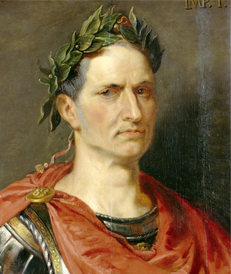
Julius
Caesar
Founder of the Roman
Empire
His name "Caesar" was
given to all emperors and is
the basis for later
titles such as Kaiser and Tsar.
During
this era, Rome experienced significant political changes. Caesar
Augustus, who became Rome's first emperor, established a system where
power was concentrated in his hands while maintaining the appearance of
a republican government. This shift in power dynamics allowed for more
stability and centralized control over vast territories. Under the
Principate, emperors wielded absolute authority but often relied on
Senate support to maintain legitimacy. This period saw several notable
emperors such as Tiberius, Caligula, Claudius, and Nero. Some brought
prosperity and peace to Rome, while others faced criticism for their
excesses.
The Influence of
Christianity on the Roman Empire
During the later years of the Principate, Christianity emerged as a
significant religious movement within the empire. Initially considered
a sect within Judaism, it gradually gained followers across different
social classes. The rise of Christianity posed challenges to
traditional Roman beliefs and practices. The Romans were polytheistic
worshippers who revered multiple gods and goddesses. Christianity, with
its monotheistic beliefs and emphasis on moral values, clashed with the
polytheistic traditions of Rome.

Pope Saint Julius II of Rome
at the Battle of Mirandola
(Art by the Pontifical Apostolic Library)
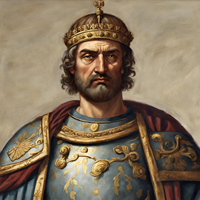
Constantine VII, Byzantine
Emperor of Rome
Indeed, the history of both the Latin and the Orthodox Churches is closely intertwined with that of the Roman Empire. After the fall of the Western Roman Empire in 476 AD, power and influence shifted to various entities. One significant development was the emergence of the Roman (Latin) Church as a successor to the empire, while the various Orthodox Churches remained strongly linked to the Eastern Roman Empire (also later known as the Byzantine Empire). The United Roman-Ruthenian Church descends in Apostolic succession from the Latin (Roman Catholic) Church and Greek, Russian, Syrian, Coptic, and Armenian Orthodox Churches.

Emperor Constantine the Great
One key event that solidified this transition was the "Gift of Constantine." Emperor Constantine the Great donated the Roman Empire and its authority to Pope Sylvester I. Another pivotal moment came with the Donation of Pepin. In 756 AD, Pope Stephen II sought assistance from King Pepin of the Franks against Lombard forces threatening Rome. In return for Pepin's military aid, Stephen anointed him King of the Franks and gave him control over territories in central Italy. This marked the birth of what would later become known as the Papal States, also known as the States of the Church, or the Pontifical Roman State.

Matilda,
Margravine of Tuscany
Vice-Queen of Italy
Later, Matilda, Margravine of Tuscany, a powerful figure in medieval Italy, played a significant role in solidifying the temporal authority of the Roman Pope. As the Imperial Vice Queen of Italy, she made a bold move by giving her lands and titles to the Roman Pope, solidifying his office as the overlord of Italy. This act took place during a time when political and religious power were intricately intertwined. By relinquishing her possessions to the Church, Matilda not only demonstrated her devotion but also bolstered the authority of the Bishop of Rome in secular matters.
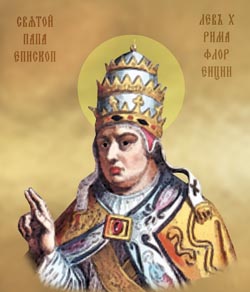
Pope St. Leo X
However, these titles eventually reverted back to Florence (in Tuscany), marking a shift in power dynamics. Today, the Bishop of Rome-Ruthenia holds the title of Florentine Archfather as successor to Pope St. Leo X and as ecclesiastical heir to Hugh, Imperial King of Italy. This lineage connects back to Matilda's legacy and signifies her enduring influence, which laid down a precedent that shaped centuries of history.
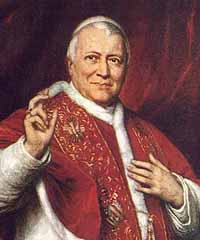
Pope St.
Pius IX
Openly known as "Papa
Rex" (Pope-King),
he embodied the concept
of sovereign temporal and spiritual authority
These donations bestowed significant temporal power upon successive Bishops of Rome, allowing them to exert political authority over substantial territories and exercise influence beyond just religious matters. This fusion of spiritual and secular power laid the foundation for the concept of a pope as simultaneously bishop and king or emperor, holding both religious and political authority.
Prince-Bishops in Europe
It
is important to note that throughout history, there were other leaders
who held similar positions of joint spiritual and temporal authority as
the Bishop of Rome. These sovereigns, known as Prince-Bishops, were
bishops who also ruled over secular territories. They held both
spiritual and temporal authority, much like the Pope-Bishop of Rome.
This concept was particularly prevalent during the medieval period,
Renaissance, and Baroque when the Church played a prominent role in
governing various regions.
Prince-Bishops were typically appointed by secular rulers or elected by
local clergy. They held significant political power and governed their
territories with the same level of authority as secular princes. These
territories varied in size and influence, ranging from small towns to
entire regions.
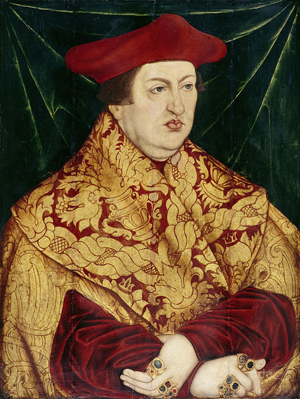
Cardinal
Albrecht v. Brandenburg
Prince-Archbishop and Elector of Mainz
One notable example of a Prince-Bishop is Albrecht von Brandenburg, who served as Archbishop of Mainz in Germany during the early 16th century. He not only held religious authority but also wielded considerable political influence as a member of the powerful House of Hohenzollern, which ruled as Kings of Prussia and later as German Emperors. The Archbishop of Mainz was one of the ecclesiastical Prince Electors that elected the Holy Roman Emperor.

Petar II
Petrovic-Njegos
Metropolitan and
Prince-Bishop of Montenegro
Another
notable example is the Orthodox Prince-Bishop of Montenegro.
This individual was not only a religious figure but also a political
leader, known for their influence over both spiritual and temporal
affairs in the region. The Prince-Bishop of Montenegro played a
significant role in shaping the destiny of the people under their
leadership. They held authority over matters such as governance, law
enforcement, and even military affairs. This dual role allowed them to
have a profound impact on both the religious and secular aspects of
society. For a long period of Montenegrin
history, Prince-Bishop
was an hereditary office. Eventually the country became a secular
kingdom.
While today many consider the Roman Pope to be the most well-known
figure when it comes to joint temporal and spiritual authority, it is
important to acknowledge that this role has existed in various forms
throughout history. Indeed, the Bishop of Rome is not alone in holding
historic temporal and spiritual authority. By recognizing
these other Prince-Bishops, we gain a greater understanding of the
diverse ways in which religion and politics have intertwined over time.
The Legacy of the Roman
Principate
The legacy of the Roman Principate can be seen in modern political
systems worldwide. Concepts such as centralized authority, bureaucracy,
and autocracy have their roots in this period. Additionally, many legal
principles developed during this time still form the basis for
contemporary legal systems. Similarly, the influence of the
Roman (Latin) Church, the various Orthodox Churches, and the
United Roman-Ruthenian Church continue to shape moral values
and ethical standards within societies around the world.
See also: Roman-Ruthenian
Nobility Association
DISCLAIMER, LEGAL, AND COPYRIGHT NOTICES